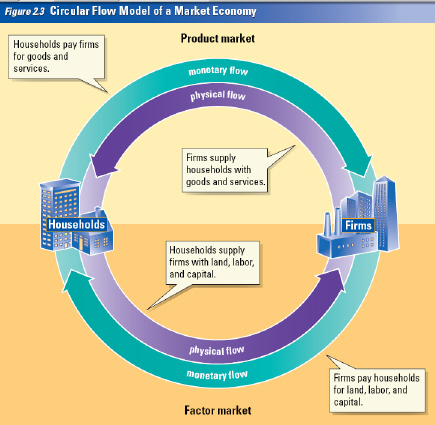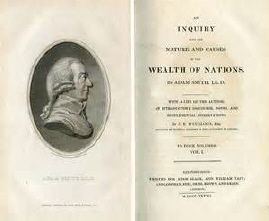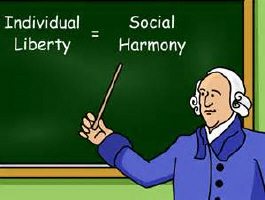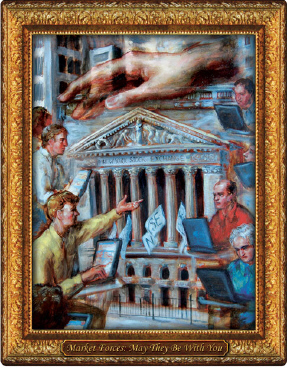|
|
|
|
|
|
1.
|
Study the introduction above
and explain the goals of this lesson. What are you expected to learn?
Also, study the vocabulary
words and look for them as you work your way through this lesson.
|
|
|
What
do a farmers’ market, a sporting
goods store, the New York Stock
Exchange, and the sign
you posted on your
community bulletin board advertising
baby-sitting services have in common?
All
are examples of markets. A market is an
arrangement that allows buyers and
sellers
to exchange things.
| Why Markets
Exist
Markets exist
because no one is self-sufficient. In other words, none of us produces all we require to satisfy our
needs and wants. You probably didn’t grow the plants to make the fibers to weave the cloth
to
make the shirt you’re wearing. Instead, you
purchased your shirt at a store, which is
an
example of a market. Markets allow us to
exchange the things we have for the things
we
want.
| | |
|
|
|
2.
|
You have a small business that
sells video games. What do you need to exchange games for money?
a. | a clean
environment | c. | a
market | b. | water | d. | community
laws |
|
|
|
3.
|
Your father is a school
teacher. His service as a teacher is converted into _____ that he can trade in the market place for
the goods and services our family needs and wants.
a. | money | c. | utilities | b. | daily lessons | d. | health benefits |
|
|
|
Specialization
Instead of being self-sufficient, each of us
produces just one or a few
products.
A nurse specializes in caring for the sick. A marine mechanic specializes in
repairing
machinery aboard sea craft. A baker
specializes in making breads, cakes,
and
cookies. Specialization is the concentration of the productive efforts of individuals
and firms on a limited number of activities.
Specialization leads to efficient use of
resources, including capital, land, and labor. It is easier to learn one task or a few tasks very
well than to learn them all.
| Buying and
Selling
Because each of
us specializes in producing just a few products, we need markets to sell what we have and to buy what
we want. The typical person earns an income (specializing at a particular job) and uses this income
to buy the products that he or she wants to consume. If each person were self-sufficient, producing
everything he or she wanted to consume, there would be no need for
markets. | | |
|
|
|
4.
|
Why is specialization necessary
for a modern economy to function?
a. | everyone owns shares in the stock
market, either directly or indirectly | c. | no one individual can produce all of the land, labor and capital needed to
satisfy their needs and wants. | b. | it protects us from global warming | d. | so people can avoid participation in the
market |
|
|
|
5.
|
In the 1970’s some
college students wanted to divorce themselves completely from modern society so they formed small
groups and moved to the desert and other remote locations. They started farms to produced all of the
food they needed to survive. Why did these communities fail?
a. | they smoked too much
dope | c. | they could not live without their
cell phones | b. | college students are stupid | d. | they discovered they could not produce all of the goods and services they
wanted and needed |
|
|
|

A circular flow model shows the interactions between households and businesses in the
free market. | |
|
|
|
6.
|
Study the graphic above. What
is exchanged in the factor market?
a. | household land, labor and capital
for company money | c. | company
specialization for company money | b. | company land, labor and capital for household
money | d. | household specialization for household
money |
|
|
|
7.
|
Study the graphic above. What
is exchanged in the product market?
a. | household land, labor and capital
for company money | c. | company
specialization for company money | b. | company land, labor and capital for household
money | d. | household specialization for household
money |
|
|
|
| Free Market
Economy
Economic systems
that are based on voluntary exchanges in markets are called free market economies. In a free market
economy, individuals and businesses use markets to exchange money and products.
In a free
market system, individuals and privately owned businesses own the factors of production, make what
they want, and buy what they want. In other words, individuals answer the three key economic
questions of what to produce, how to produce it, and who consumes that which is produced. As you
might guess, a free market economy functions best in an environment of decentralized decision-making
such as enjoyed in the United States.
|
We can represent a free market economy
in a special kind of drawing
called a circular flow diagram, or model. A circular flow diagram shows at a glance how individuals
and businesses exchange money, resources, and products in the marketplace. Figure 2.3 shows a
circular flow diagram of a free market economy. The inner ring of the diagram represents the flow of
resources and products. The outer ring represents the flow of
money.
| | |
|
|
|
8.
|
In a free market economy who
answer the three key economic
questions of what to produce, how to produce it, and who consumes that which is
produced.
a. | the local
communities | c. | individuals | b. | the U.S. Government | d. | politicians |
|
|
|
9.
|
In the graphic above, the inner
ring shows the flow or _____ and the outer ring shows the flow of _____ .
a. | goods and services
- money | c. | stocks and bonds - dividends | b. | money -
goods and services | d. | land, labor and
capital - savings and
investments |
|
|
|
| Households and
Firms
The players in the
free market economy are
households and firms. A household is a
person or group of people
living in the
same residence. Households own the
factors of production—land, labor,
and
capital. Households are also the consumers
of goods and services.
A business, or
firm, is an organization
that uses resources to produce a product,
which it then sells.
Firms transform
“inputs,” or factors of production, into
“outputs,” or
products.
Factor Market
As you can see from the
lower half of the
circular flow diagram in Figure 2.3, firms
purchase factors of production
from households. This arena of exchange is called | the factor
market. Firms purchase or rent land (natural resources). They hire workers, paying them wages or
salaries for their labor. They also borrow money from households to purchase capital, paying
households interest or profits in return. Profit is the financial gain made in a transaction.
Product Market
Take a close look at the top half
of the circular flow diagram in Figure 2.3. You can see that the goods and services that firms
produce are purchased by households in the product market.
If you follow the rings of
the diagram,
you will see that households purchase the
products made by firms with the
money
they received from firms in the factor
market. The flow between the factor market
and
the product market is truly circular. | | |
|
|
|
10.
|
Which item below is
not a factor of
production?
a. | profit | c. | labor | b. | land | d. | capital |
|
|
|
11.
|
In the diagram above, who owns
the factors of production?
a. | households | c. | the government | b. | firms | d. | corporations |
|
|
|
12.
|
What do firms do in the graphic
above?
a. | they consume products produced by
households | c. | they convert the
factors of production into products | b. | they convert capital into land and labor | d. | they convert products into land, labor and
capital |
|
|
|
The
Self-Regulating Nature
of the Marketplace
How is it that firms and households cooperate
to
give each other what they want? —factor resources, in the case of firms, and products, in the
case of households? As anyone knows who has tried out for the track team, a part in a play, or has
applied for a job or to a college, we live in a competitive society. According to Adam Smith, it is,
in fact, competition and our own self-interest that keep the marketplace functioning.

| 
Adam Smith
Self-Interest
Adam Smith was a Scottish social philosopher
who, in
1776, published a book titled The Wealth of Nations, in which he described how the market
functions. Smith observed that an economy is made up of countless individual transactions. In each
transaction, the buyer and seller consider only their self-interest, or their own personal
gain. Self-interest, in other words, is the motivating force in the free
market. | | |
|
|
|
13.
|
According to Adam Smith, what
keeps the market functioning?
a. | competition among
individuals | c. | self sacrifice and
altruism | b. | the desire to do good | d. | self sacrifice and competition |
|
|
|
14.
|
According to Adam Smith, what
motivates people in a free market?
a. | concern for
humanity | c. | love of
country | b. | attending to the needs of the rich and poor | d. | self interest |
|
|
|
Competition
Consumers (households), in pursuit of their
self-interest, have the incentive to
look for
lower prices. An incentive is the hope of
reward or the fear of punishment
that
encourages a person to behave in a certain
way. Adam Smith observed that people
respond
predictably to both positive and
negative incentives. As for consumers, we
can predict that
they will respond to the
positive incentive of lower prices, because
spending less money on a
good lowers the
opportunity cost of the purchase.
Firms, meanwhile, seek to make
greater
profits by increasing sales. Let’s take, for
example, a shirt manufacturer. The
manufacturer finds that striped shirts are far outselling polka-dotted shirts. The manufacturer has
the incentive—from more potential sales and profits—to produce more striped shirts. Other
manufacturers, observing consumers’ desire for striped shirts, also have the incentive to sell
them. With all these manufacturers in the market, consumers have all the striped shirts they
want. |
Manufacturers also have a second incentive —to make the most profit
in selling striped shirts. What keeps manufacturers’ pursuit of profit from causing
prices to skyrocket? If one begins charging $30.00 for a striped shirt, another can sell striped
shirts for $25.00. If the first manufacturer wants to sell any more striped shirts, he or she had
better drop the selling price. Consumers, pursuing their self-interest, will buy the lower-priced
shirt. Economists call this struggle among producers for the dollars of consumers competition. While self-interest is the motivating
force behind the free market, competition is the regulating force.
Incentives come in two
forms. Profit is a
monetary incentive, or an incentive that
rewards in the form of
money. Nonmonetary
incentives reward consumers and business in
other ways, such as
gifts, services, and other
goods | | |
|
|
|
15.
|
What lowers the opportunity cost of a
purchase?
a. | spending more money on a good or
service | c. | correctly
estimating the value of a good or service | b. | spending less money on a good or
service | d. | postponing the purchase of a good or
service |
|
|
|
16.
|
What regulates the free
market?
a. | price | c. | government policy | b. | cost | d. | competition |
|
|
|
17.
|
In the shirt example above,
what is the benefit to consumers when buyer and seller compete and act in their own self
interests?
a. | fewer shirts but at a price low
enough for everyone to afford | c. | higher prices but better shirts | b. | more shirts at a lower
price | d. | poorer quality shirts but at a cheaper
price |
|
|
|
18.
|
You want to purchase a new
Samsung television for Christmas. Best Buy and Walmart offer the same television at about the same
price but Walmart is giving away a Christmas turkey with each television purchase. What kind of
incentive is Walmart offering?
a. | monetary | c. | discount | b. | non-monetary | d. | profit |
|
|
|
The
Invisible Hand
Self-interest and competition work together to regulate the marketplace. Self-interest
spurs consumers to purchase certain goods and services and firms to produce them. Competition causes
more production and moderates firms’ quests for higher prices. The overall result is that
consumers get the products they want at prices that closely reflect the cost of producing them. All
of this happens without any central plan or direction. Adam Smith called this phenomenon “the
invisible hand of the marketplace.”
 Eventually the Invisible
Hand Will Balance Supply and Demand and bring down the price Eventually the Invisible
Hand Will Balance Supply and Demand and bring down the price |

Market Forces
The Invisible Hand | | |
|
|
|
19.
|
In a free market, what
motivates companies to keep their prices low?
a. | self-interest | c. | competition | b. | government regulation | d. | altruism |
|
|
|
20.
|
What is the invisible
hand?
a. | government control of the free
market to maximize productivity that benefits everyone | c. | self regulation of a free market brought about through competition and
everyone doing what is best for himself. | b. | the equal distribution of land, labor, capital and money among all
citizens | d. | self regulation of a free market
brought about by everyone looking out for the interests of others in the
market |
|
|
|
21.
|
In the cartoon above, what will
eventually bring down the price of gasoline?
a. | competition among the gasoline
suppliers | c. | cars that use more
gasoline | b. | government price controls | d. | higher demand for gasoline |
|
|
|
Advantages
of the Free Market
Competition and the pursuit of self-interest
serve the public interest. The free
market,
on its own, meets many economic goals.
1. Economic efficiency Because it is
self regulating, a free market economy
responds efficiently to rapidly changing
conditions.
Producers make only what
consumers want, when they want it, and
generally at prices they are
willing to pay.
2. Economic freedom Free market
economies have the highest degree
of
economic freedom of any system. This
includes the freedom of workers to work
where they
want, of firms to produce
what they want, and of individuals to
consume what they
want.
3. Economic growth Because competition
encourages innovation, free
markets
encourage growth. Entrepreneurs are
always seeking profitable
opportunities,
contributing new ideas and innovations.
|
4.
Additional goals Free markets
offer a
wider variety of goods and services than
any other system, because producers
have
incentives to meet consumers’
desires. Consumers, in essence, decide
what gets produced.
This is called
consumer sovereignty.
Despite its advantages, no pure
market
economy exists on any meaningful scale.
The same features that make free
markets
attractive also represent the weaknesses of
the free market. The goals of
economic
equity and economic security are difficult
to achieve in a pure market system.
In
Section 4, you will read about how the free
market system has been modified by
various
nations in order to better meet the
entire array of economic
goals.
| | |
|
|
|
22.
|
What does the following phrase
from the reading above mean? “Competition and the pursuit of self-interest serve the public
interest.”
a. | Society benefits if everyone
competes and does what is best for themselves. | c. | The public interest is only served when people compete but serve others at the
same time | b. | Competition defeats self-interest and therefore helps
society | d. | The public is not interested in self-interest and
competition |
|
|
|
23.
|
In a free market economy, who
decides what is going to be produced?
a. | businesses | c. | the government | b. | consumers | d. | custom and tradition |
|
|
|
24.
|
In a free market economy there
is very little waste in the production of goods and services. What is this
called?
a. | consumer
sovereignty | c. | economic
efficiency | b. | economic freedom | d. | economic growth |
|
|
|
a. | specialization | d. | market | b. | household | e. | factor market | c. | profit | f. | firm |
|
|
|
25.
|
a person or group of people living in the same
residence
|
|
|
26.
|
the financial gain made in a
transaction
|
|
|
27.
|
an arrangement that allows buyers and sellers to exchange
things
|
|
|
28.
|
an organization that uses resources to produce a product,
which it then sells
|
|
|
29.
|
the concentration of the productive efforts of individuals
and firms on a limited number of activities
|
|
|
30.
|
market in which firms purchase
the factors of production from households
|
|
|
a. | product
market | d. | self-interest | b. | invisible hand | e. | competition | c. | incentive | f. | consumer sovereignty |
|
|
|
31.
|
the power of consumers to
decide what gets produced
|
|
|
32.
|
one’s own personal gain
|
|
|
33.
|
the struggle among producers for the dollars of
consumers
|
|
|
34.
|
the market in which households
purchase the goods and services that firms produce
|
|
|
35.
|
term economists use to
describe the self regulating nature of the marketplace
|
|
|
36.
|
an expectation that encourages people to behave in a
certain way
|